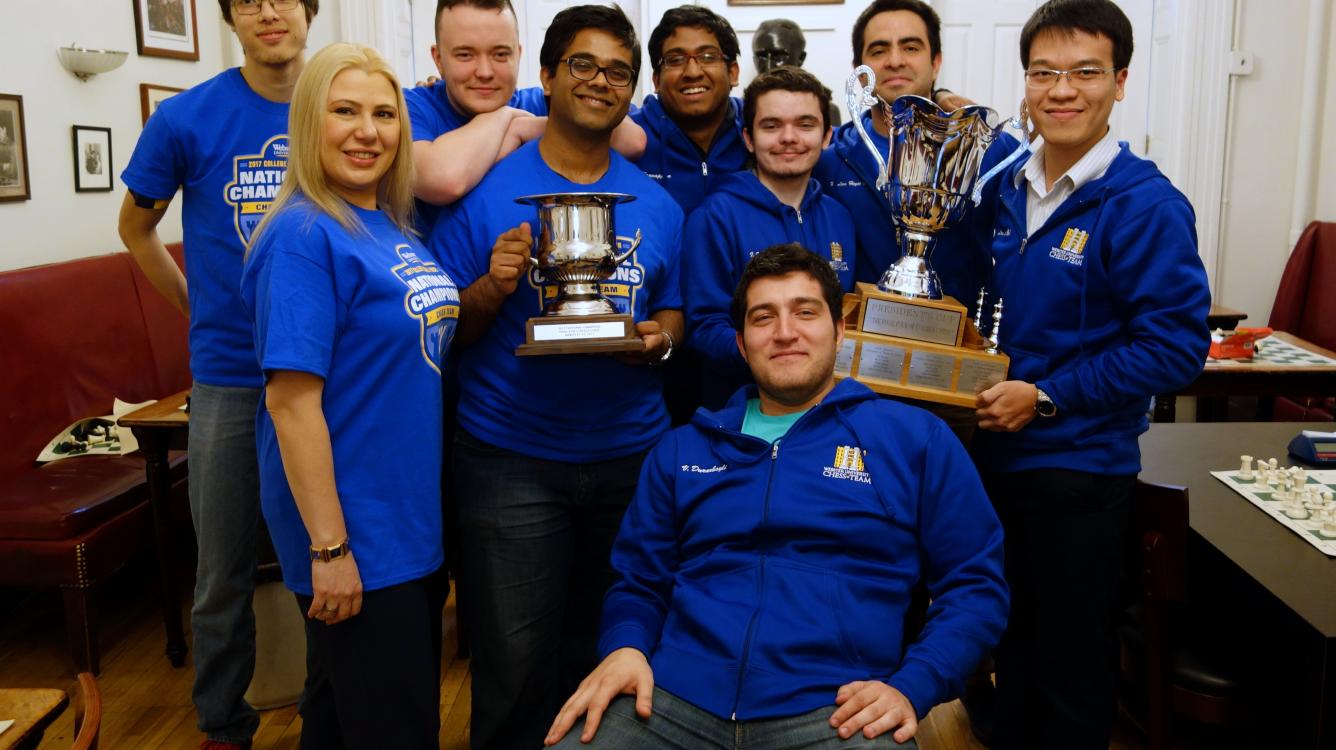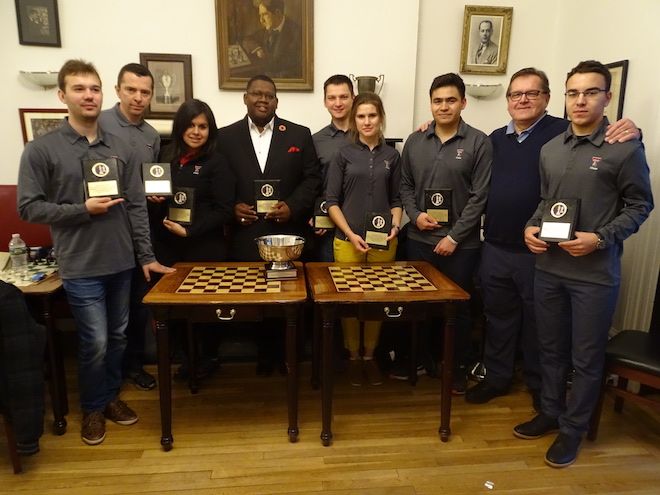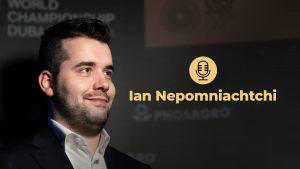
Webster University Wins 5th Straight President's Cup
Top-rated Webster University has won its fifth consecutive President's Cup title, beating out the three other invited teams from Texas Tech, St. Louis University, and University of Texas at Dallas (UTD) in an event also known as the "Final Four of College Chess." About the only question this past weekend was whether the Gorloks would be competing for one or two titles.
Last week, their quartet of college players was denied a chance for a world championship when it was bounced from the PRO Chess League. Instead, the players were then able to focus their efforts on another national championship, which they won with their usual relative ease.
(The Arch Bishops' win in the PRO Chess League means the city celebrated two titles in one day!)

The winning team before one of the rounds, and yes, college kids don't like to wake up early. Left to right: Coach GM Susan Polgar, a slightly asleep GM Aleksandr Shimanov, GM Ray Robson, GM Illya Nyzhnyk, Captain GM Le Quang Liem. All Webster photos courtesy Paul Truong.
Webster is actually deep enough to field two competitive teams simultaneously, which was almost needed this past weekend, but it didn't come to that. Instead, it could roster its four best players, since unlike the PRO League, there's no rating cap in the national championship of U.S. colleges.
In order to be able to compete, you must be one of the top four colleges in December's Pan-Am Intercollegiate Championship. In fact Webster players comprised the top two teams, but by rule could only send one contingent. Whereas it sometimes suffers a minor slip in that event, it has a complete hegemony once advancing to the Final Four.

GM Aleksandr Shimanov, still asleep. But that's what teammates are for, right GM Le Quang Liem?
Like the past four championships, the intimate event was once again in New York, although it moved this year from the New York Athletic Club to the Marshall Chess Club. Webster's average U.S. Chess rating (2737) was nearly 100 points higher than second-seeded St. Louis -- all five of the players who saw action were above 2700 in the national ratings.
Round one on Saturday morning was classic: "win as White, draw as Black" team play against Texas Tech. Both GMs Le Quang Liem (the captain) and Ray Robson (co-captain) won on the odd boards, while GMs Illya Nyzhnyk and Aleksandr Shimanov held on the evens (the only spot of trouble was Shimanov's ending, but he coyly found an exchange-down fortress).

How confident was Webster of its continued success? It had t-shirts at the ready with this logo, which players donned just after the final round for the awards ceremony.
Robson's adventurous play is rarely confused with his former roommate/teammate Wesley So's. Here's his opening-round win, where his knight had a case of happy feet. Even amateur players have it memorized that it takes a knight four hops to move two squares away diagonally, but how often do you see it happen on four consecutive moves of the opening 10?
Tech would recover to win 1.5 out of the next two rounds, and clinched second place. After three straight years of finishing third, this was its highest finish in the President's Cup since winning in 2011 and 2012.

Second-place Texas Tech Red Raiders. Left to right: IM Sergei Matsenko, Coach/Program Director GM Alex Onischuk, WCM Claudia Munoz, Dr. Paul Frazier, GM Andrey Baryshpolets, WIM Iryna Andrenko, Former Program Head/Current U.S. Chess College Committee Chair Al Lawrence, IM Luis Torres, IM Pavel Vorontsov.
Tech did it despite fielding only one GM and three IMs in its lineup (only one other IM played!). In particular, the 2.0/3 from IM Luis Carlos Torres (playing 200+ points up every round at 2356 and by far the lowest-rated player who competed) was quite an achievement.

Webster Provost Dr. Julian Schuster (far left) made the trip to root on his players. Here, they return home from New York...

...and assemble one last time at Lambert International Airport, site of many trophy comings and goings over the last decade. The complete team, left to right: GM Vasif Durarbayli, GM Priyadharshan Kannappan, Coach GM Susan Polgar, Provost Dr. Julian Schuster, GM Illyan Nyzhnyk, GM Ray Robson, GM Ashwin Jayaram, GM Aleksandr Shimanov, GM Le Quang Liem, GM Manuel Leon Hoyos. (Jayaram and Hoyos were not on the six-person roster but took the trip anyway thanks to being on the qualifying team, which got Webster its spot in New York.)
Round two, also on Saturday and also with the same colors for the champions, was a narrower affair for Webster. Yes, it beat UTD, but Robson this time lost as White in only 26 moves. Le won again on top board, and only Shimanov's win on board four got them to the required 2.5/4.
On Facebook, Webster Assistant Coach FM Paul Truong joked that he was "outfoxed" by the legal, last-hour substitution of two "super subs" by UTD Coach IM Rade Milovanovic, calling the move the "nuclear option."
Here's the flip side to Robson's enthusiasm. Things began to go wrong with 13. h4?! The move is great for the fans, but not so much for coach GM Susan Polgar.
It turns out it just wasn't the best setting on Saturday afternoon for lightning h-pawn attacks. GM Angel Arribas Lopez of UTD tried to justify his own with a piece sac, and although Polgar likely worried about her fourth board too, the Webster player pulled it out with a nifty ending move.
You normally wouldn't ever trade your last pawn when trying to win an ending, but Shimanov had a good reason. Still, even after his correct advance he came within 10 moves of the 50-move rule before White panicked and moved a pawn.
In the final round Sunday morning, Nyzhnyk sat out, moving Robson up to board two for his third turn making the first move! How often do you play all Whites in an entire tournament?
That wasn't the star coaching move though. Polgar had two options to insert on board four: GM Priyadharshan "P-Diddy" Kannappan, or GM Vasif Durarbayli? She went with the Azeri.
After Le drew on top board against Millionaire Chess 3 winner GM Darius Swiercz, and Robson drew GM Yaroslav Zherebukh in a U.S. Championship preview, the substitute won. The only decisive game of the round was the difference against St. Louis.
Here's the winner of the big game kibitzing with his teammates and coach after the giving his team the successful title defense.
To show you how much difference a three-rounder can make, if the result of this game were flipped, St. Louis would have ended in a tie with Webster. Instead, the Billikens finish on equal second at 1.5/3 but take third behind Texas Tech on total game points tiebreakers. UTD, winners of the first two editions of the event in 2001 and 2002, mustered a lone match draw and took fourth.

The fourth-place UTD team. accepts their trophy Photo courtesy Al Lawrence.
The fifth win for Webster also nudges it ahead of UTD for second-most Final Four titles overall, 5-4. The lifetime record stands at six and is held by University of Maryland, Baltimore County (UMBC), which hasn't been able to add to its history since it hasn't qualified in either of the last two years. However, UMBC's record for most consecutive titles (four from 2003-2006) has been overtaken by Webster's five.
The tournament also represents quite a run of team play for Webster's Robson. In September, 2016, he won gold with fellow Americans at the Olympiad. Then in December his Webster "A" team tied for first at the Pan-Am Intercollegiate Championship. This winter he led his Webster Windmills to the round of eight in the PRO Chess League before this weekend's title defense in New York City.

St. Louis University finished third in its first year of fielding a competitive chess program. That's right, there is even more of a chess culture in that city. The team receives support from the Chess Club and Scholastic Center of Saint Louis, and is coached by GM Alejandro Ramirez (standing right). Also pictured (left to right): GM Yaroslav Zherebukh, Nozima Aripova, GM Darius Sweircz, IM Cemil Can Ali Marandi, GM Francesco Rambaldi). Photo courtesy St. Louis University/Steve Dolan.
One of the event's "growing pains"? The tournament has now endured long enough that the yearly engravings of winning teams have filled up the base of the trophy. As you can see Tournament Director Mike Hoffpauir explain, they'll starting adding extra base layers to the bottom of the trophy to keep the tradition going.



